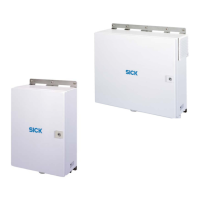Chapter 10
MSC800
124 Operating instructions | SICK 8011540/14B8/2019-06-06
Subject to change without notice
10.5 Glossary
For other terms, see also the online help for the SOPAS-ET configuration software.
Also known as linear code or bar code.
Field of dark bars and light gaps arranged in parallel (both together referred to as
elements), which can be depicted according to a specific regulation (specification) on
the medium (background) using various marking procedures.
An appropriate number and combination of machine-readable bars and gaps results in an
(alpha)numeric character which can be read by the user. As the entire coded information,
bordered by start and stop characters, is completely available in one dimension, and is
also usually recorded in lines, this bar code is referred to as a linear code. The various
1D code types differ in terms of the stock of characters that can be coded, the structure
(number of elements per line, number of characters, start/stop characters, mark of
conformity), the information depth, and the print tolerances. The length of the code bars
and gaps is not significant for the information content. However, longer code bars and
gaps can be detected more easily with the reading device.
Also known as matrix codes. This group also includes stacked codes.
In the two-dimensional code, the information is arranged in a greater density with the aid
of dark and light cells (squares) in a matrix. The vertical and horizontal arrangement of the
cells relative to the reference points in the middle and at the edges determines the data
content, which is defined by the specification. For error correction during reading, the code
is equipped with a redundancy via a mathematical process (e.g., in the case of data matrix
ECC200 via error correction code words). The omni-directional reading of 2D codes is
carried out using image processing.
Logical auxiliary data interface of the MSC800 in dual design (AUX 1/2). Can be physically
switched in each case to serial RS-232, RS-422/485 and Ethernet (default: port 2111 /
port 2113).
The serial data interfaces are used for diagnostics (output of read diagnostic data or
monitoring of the data traffic of the host interfaces in the fixed data format), and also offer
special protocols or customer-specific data output formats, as well as the general
adjustable data format and transmission rate. The data output of the serial data interfaces
can be deactivated in each case.
The two Ethernet Aux ports are used for the output of read diagnostic data in the fixed
data output format, and the Aux2 port also offers special protocols or customer-specific
data output formats. The data output of the Aux2 port can be deactivated, but the data
output of the Aux1 cannot be. It is always possible to gain access to the MSC800 for
operation and configuration via the auxiliary data interface using the PC and the SOPAS-ET
configuration software.
Special function of the Aux interface of the MSC800. Used for subsequent manual entry
of code data in order to complete read results sent to the host.
1D code
2D code
Aux interface
Auxiliary input

